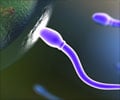A study led by researchers at UC San Diego and UC Irvine has uncovered evidence that supports the theory that sperm swim much faster when faced with competition.
The researchers have found that sperm cells from the more promiscuous chimpanzee and rhesus macaque species swim much faster and with much greater force than those of humans and gorillas, species where individual females mate primarily with only one male during a reproductive cycle.Michael Berns, an adjunct professor of bioengineering at UCSD and a professor of biomedical engineering at the Beckman Laser Institute at UC Irvine, and UCSD Ph.D. candidate Jaclyn Nascimento have reported their findings in the Journal of the Royal Society Interface.
As per the theory, female chimps and macaques typically mate with several males in a social group, so that a male with faster and stronger swimming sperm cells would be more likely to successfully fertilize an egg.
“Rapidly swimming sperm cells would be evolutionarily favoured when the mating pattern is polygamous and that is consistent with our measurements of chimp and rhesus macaque sperm,” said Nascimento.
“Dominant silverbacks are known to effectively discourage other males from mating with the females in their harems, so faster sperm wouldn’t seem to be an advantage to them,” Nascimento added.
The researchers have also found that the speed and force of human sperm falls in between the gorillas and the chimps, which indicates that humans have not always been as monogamous as thought.
“Maybe humans haven’t always been as monogamous as we had thought,” Berns said. It was with the help of adjustable laser tweezers and sperm-tracking software that the researchers were able to precisely and accurately measure swimming force and speed of hundreds of individual sperm cells from males of the four primate species.
“While biologists have been interested in this sperm competition question for years, it required the collaboration of biologists, physicists and engineers to design the right equipment to test the theory,” said Berns.
Source-ANI
LIN /J







